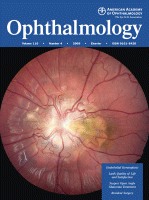Abstract
PURPOSE: To learn whether electrophysiological changes indicating amblyopia occur even in the absence of clinically recognizable amblyopia.
DESIGN: Prospective study.
METHODS: Four consecutive infants between 7 and 19 months of age with unilateral periocular vascular lesions that intermittently obstructed vision in the affected eye and no clinical evidence of amblyopia were evaluated. No child had anisometropia greater than 0.50 diopter in the greatest meridian or strabismus. Sweep visual evoked potential vernier acuity was measured under monocular viewing conditions with the fellow eye tested as the control.
RESULTS: Response amplitudes and acuity thresholds were significantly diminished in the affected eyes. A phase analysis showed slowing of the response in the affected eyes compared with the control eyes.
CONCLUSIONS: An amblyopia-like effect on vernier acuity occurred in infants with unilateral periocular vascular birthmarks when the lesion caused intermittent occlusion of the eye. Whether long-term effects will occur is unknown, but children with no clinically apparent amblyopia in the setting of a vascular mark or other cause of intermittent occlusion of the visual axis should be followed, since these electrophysiology findings suggest amblyopia may be present.

